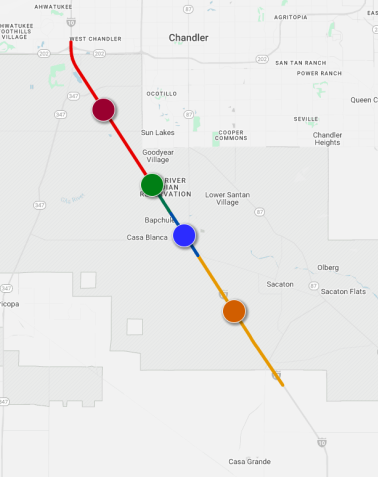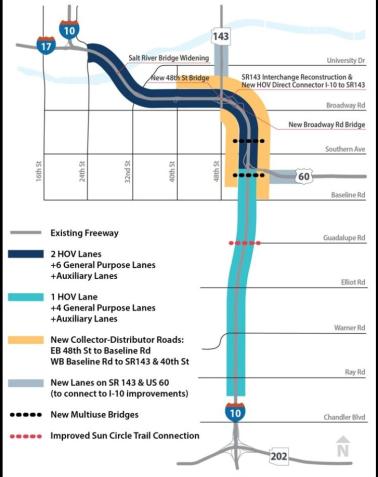Request for Information – Solar P3 Projects
The Arizona Department of Transportation (ADOT) invites interested parties (Respondents) to respond to these Requests for Information (RFI) regarding a prospective future solicitation for the deployment of solar photovoltaic generated electricity from:
- P3-25-01 RFI - ADOT Building Sites (rooftops, covered parking structures)
- P3-25-02 RFI - ADOT ROW Sites (excess vacant land along state highways)
The purpose of this RFI is to seek the industry’s perspective and feedback on the questions presented herein and to provide an opportunity for industry input on the overall procurement process for the Project.
Responses are due on January 16, 2026, at 2:00 PM MST, to [email protected].
RFP for EV Infrastructure Implementation
The Arizona Department of Transportation (ADOT) released a Request for Proposals on October 17, 2025, seeking qualified developers to design, build, operate, and maintain Electric Vehicle (EV) charging infrastructure under the National Electric Vehicle Infrastructure (NEVI) Formula Program.
ADOT will host a virtual pre-proposal conference Friday, November 21 from 11:00am to 12:00pm MST. Further details and meeting links will be posted at azdot.gov/ev-infrastructure-implementation.
Proposals are due on January 16, 2026, at 2:00 pm MST.
Public Private Partnerships (P3)
Public Private Partnerships (P3)
In its simplest definition, a P3 is an alternative method of project delivery—a type of procurement. More broadly, P3s are a form of contracting that shares risk and occupies the space between two extremes of traditional procurement and privatization. A ‘typical’ P3 project does not exist as they are generally best suited for complex, atypical projects.
Traditional Procurement

Public Private Partnerships

Privatization
Traditional Procurement
Typical Design-Bid-Build-Contracting. Lowest bid is the winner. High risk for the public agency; low risk for the Contractor.
Public Private Partnerships
A method of public-private contracting that shares risk between traditional procurement and privatization. Focused on best value and life cycle optimization.
Privatization
Private company takes on all the risk. Owns the asset for a pre-determined number of years.
Unsolicited Proposals
ADOT welcomes creative and innovative ideas that provide material benefit to the State and encourages the private sector to place a strong emphasis on innovation when developing an Unsolicited Proposal.
External entities considering submission of an Unsolicited Proposal are strongly encouraged to request a meeting with the P3 Office to have preliminary discussions prior to development and submittal of a formal Unsolicited Proposal per the ADOT P3 Guidelines.
P3 Delivery Methods
ADOT has broad authority under the P3 statute to use project delivery methods or agreements or combination of methods or agreements that will serve the public interest. Examples of potential project delivery methods include:
- Predevelopment agreements leading to other implementing agreements
- A design-build agreement
- A design-build-maintain agreement
- A design-build-finance-operate agreement
- A design-build-operate-maintain agreement
- A design-build-finance-operate-maintain agreement
- A concession providing for the private partner to design, build, operate, maintain, manage or lease an eligible facility
- Any other project delivery method or agreement or combination of methods or agreements that the department determines will serve the public interest
Potential Benefits of P3 Delivery
- Lower transaction costs: Working with a single private partner across all stages of the project eliminates the costs of developing, awarding and monitoring separate contracts at each stage. In other words, a P3 can reduce the transaction costs of bringing the private sector into the project.
- Synergy across the phases: Working with a single private partner across all stages provides a powerful incentive to design and construct the facility to minimize the long-term costs to staff, operate, and maintain it.
- Expedited delivery: With the cost of labor and materials increasing steadily each year, the private partner is incentivized to complete the construction as quickly as possible. Most research on P3s shows that they are almost always completed faster than traditional procurements.
- Cost certainty: At the point of contract execution, the private entity confirms not only the cost of design and construction, but also the long-term costs to operate and maintain a facility — known as its life cycle costs — which provides substantial financial and political benefits.
- Risk transfer and performance focus: With the transfer of risks and potentially operations and maintenance responsibilities, P3s have a much larger emphasis on outcomes. In a traditional procurement, the government tells the design consultants and build contractors what to design, how the highway should look, what materials should be used to build it, and so forth. This approach is popular and timeless because we know how to hold everyone accountable.
- P3s demand a different approach. Presumably, the highway should provide a specific level of service based on traffic patterns. But how the highway facility looks and works would be up to the private partner. Instead of tracking as to whether certain specifications were met, government can now monitor traffic operations, pavement smoothness, cleanliness, and enforce the other contract provisions.
- Innovation: Innovation is the process of creating something new or improving an existing product, idea, or field and can involve introducing new goods, methods, markets, sources, or organizations. Through the transfer of risk and focus on performance, the private partner is provided the ability and incentive to optimize the project for the long-term and bring forth new and innovative designs, materials, means and methods for construction, operations, and maintenance.
*These may not apply to every P3 project.
Active Projects
Rest Area Maintenance (ReSOURCE)
ADOT's 32 highway safety rest areas are now managed under one contract under the agency’s first public-private partnership contract. The contract, which took effect in 2013 and was re-procured in 2018 and 2023, means a better experience for travelers at the rest areas and a comprehensive statewide approach to minor and major maintenance for ADOT. It is also through this P3 contract, that the Safe Phone Zone program started.
Active Project Documents
Completed Projects
Flagstaff District and MVD Facilities land swap (2019)
Program Guidance
Resources
Frequently Asked Questions
What are the key benefits of P3s, and how do P3s benefit Arizonans?
P3s make it possible to deliver much needed transportation projects in a timely manner, often years before the projects could be delivered using traditional project-delivery methods. Because P3s are business ventures for the private sector, the private sector has become efficient at delivering projects under this method. These efficiencies, combined with the private sector's resources provide a greater value for money for the public owner. In short, P3s make it possible for Arizonans to get much-needed transportation improvements faster than if conventional delivery methods are used, thus providing more travel options, reducing congestion and improving roadway safety for Arizonans.
What are the differences between a P3 and the way ADOT typically does a transportation project?
ADOT’s conventional project-delivery method is often referred to as Design-Bid-Build (DBB). Under a conventional project-delivery method, ADOT finances both the design and construction of a transportation project. First, ADOT typically bids out and oversees the engineering design. Once the design is complete, ADOT then bids out and oversees the project's construction. Once the construction is complete, ADOT assumes the operations and maintenance of the facility.
Under a P3, ADOT bids one contract for the project, and the resulting P3 agreement covers both the design and construction of the project. It may also include the operation and maintenance of the facility by the private partner for a defined duration.
The private partner is responsible for managing and operating the project for the term length, with ADOT serving in an oversight role. The private partner typically is responsible for adding future capacity to enhance the ongoing operations of the project. Under most [1] [2] [3] circumstances, ownership of the project remains with ADOT.
What types of projects can be done using a P3?
Eligible projects include those that are used or are useful for the safe transport of people, information or goods via one or more modes of transportation, including enhanced, upgraded and new facilities. Eligible projects could involve any of these facilities:
- Airports
- Boats
- Bridges
- Bus systems
- Conduits
- Ferries
- Fixed guideways
- Guided rapid transit
- Highways
- Intermodal or multimodal systems or any other mode of transport
- Monorails
- Parking
- Railways
- Rail yards or storage facilities
- Rolling stock
- Structures
- Transit
- Tunnels
- Vessels
- Vehicles
- Other related equipment, items or property
Who owns a transportation facility constructed under a P3?
ADOT retains control and ownership and sets the standards and rules of the P3 facility.
How long will a P3 agreement last?
In Arizona, the term of a P3 agreement can extend up to 50 years. However, ADOT may extend a P3 for additional terms.
Will existing roads be tolled?
No. Legislation requires that any P3 agreement must be used for a “new, upgraded or enhanced facility.” Therefore, P3s can be used for new facilities or for expansions to existing facilities. Existing lanes cannot be tolled under current law.
How can I reach the Office of P3 Initiatives?
You can send us an email or call 602.712.4258.
Contact Us
General Phone: (602) 712-4258
Email: [email protected]





